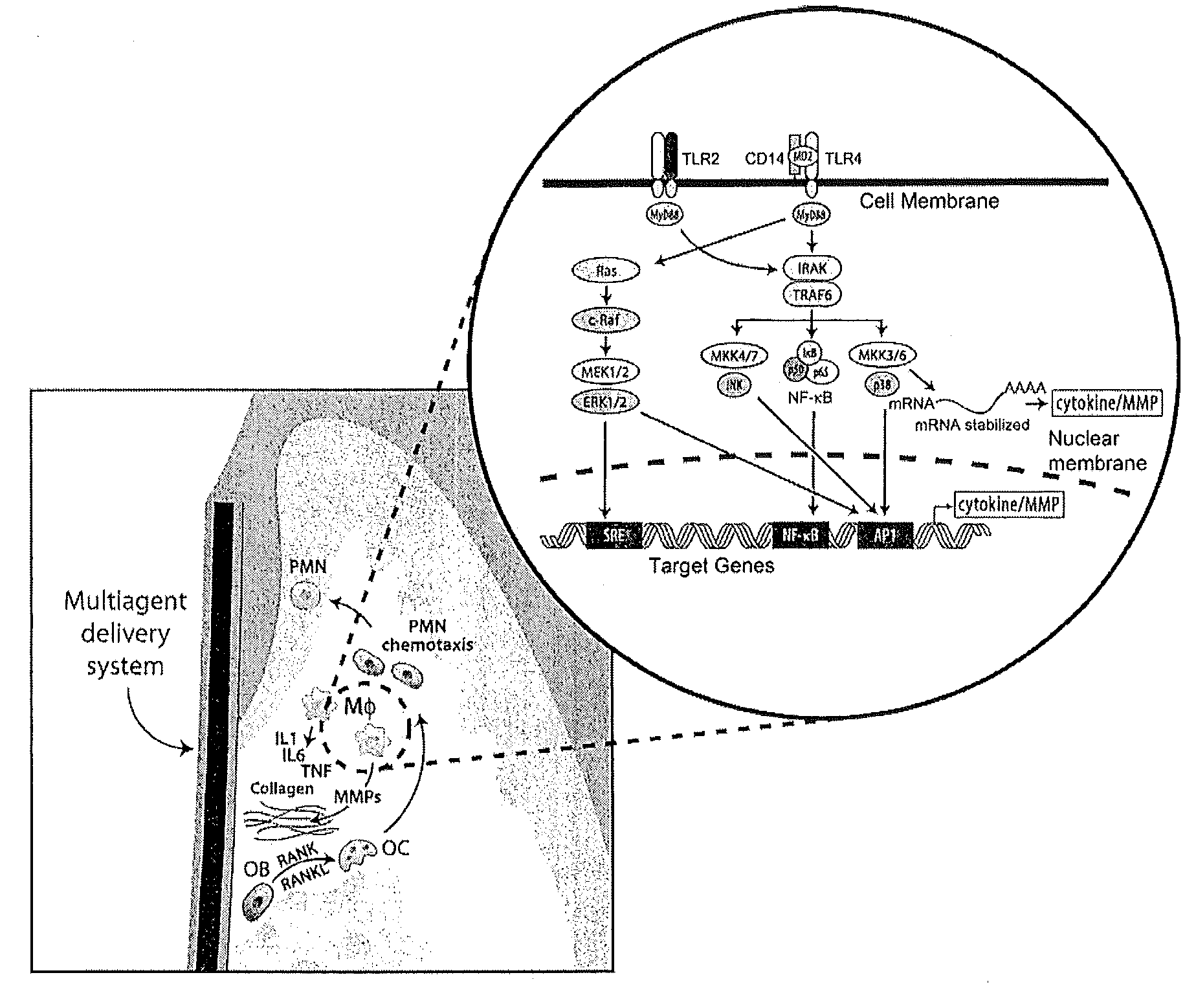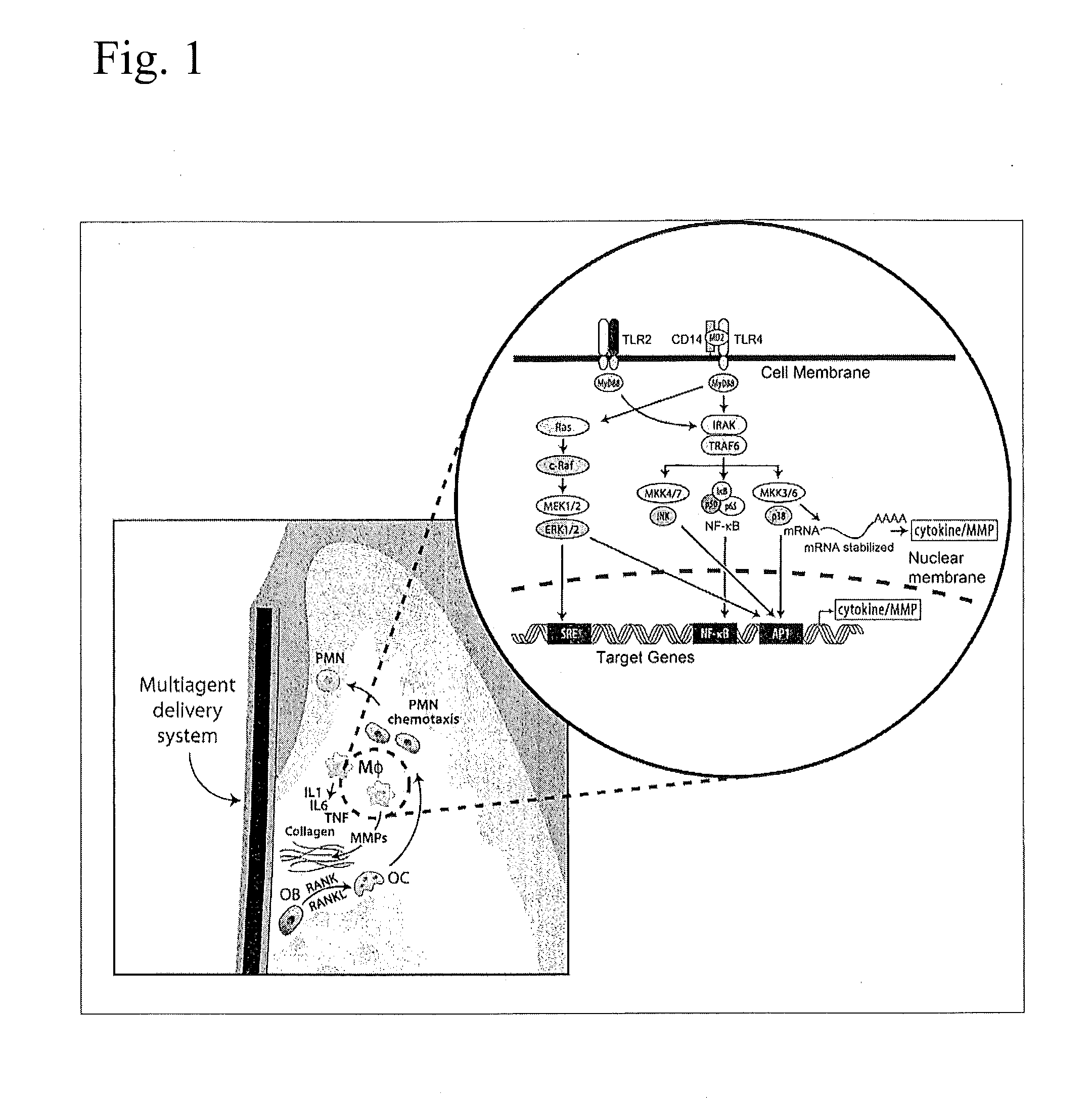Methods and compositions for temporal release of agents from a biodegradable scaffold
a biodegradable scaffold and agent technology, applied in the direction of drug compositions, prosthesis, peptides, etc., can solve the problems of inability to achieve regeneration, inability to achieve consistent clinical results, and inability to be approved for therapeutic use, so as to improve tissue regeneration and/or healing, reduce inflammation, and reduce inflammation
- Summary
- Abstract
- Description
- Claims
- Application Information
AI Technical Summary
Benefits of technology
Problems solved by technology
Method used
Image
Examples
example 1
Cytokines are Required for Periodontal Disease Progression.
[0114]In the oral microbial environment, bacterial constituents including Gram-negative derived lipopolysaccharide (LPS) can initiate inflammatory bone loss as seen in periodontal diseases. LPS can stimulate the expression of IL-1β, TNF-α, IL-6 and RANKL by activating the innate immune response1-3. The production of inflammatory cytokines results from the activation of kinase-induced signaling cascades and transcriptional factors. LPS initiates this cascade by binding CD14 as well as toll-like receptors (TLRs), mainly TLR-2 and TLR-44-6. Regardless of which TLR is engaged, LPS increases RANKL, IL-1, PGE2 and TNF-α, each known to induce osteoclast activity, viability and differentiation7. In addition, activated monocytes, macrophages, and fibroblasts all produce cytokines such as TNF-α, IL-1β, PGE2, and IL-6 within periodontal lesions8,9 and are significantly elevated in diseased periodontal sites compared ...
example ii
[0177]Diabetic ulcers are the most common foot injuries leading to lower extremity amputation. They are a major predictor of limb loss in diabetics, with a rate of 6.5 amputations per 1000 person-years, which about 10 times more than non-diabetics. They are also an accelerator of mortality for diabetic patients, with an annual incidence per diabetic patient of 2.4% to 5.6%, a prevalence of 4.4% to 7.7% and a lifetime incidence of approx. 15%
[0178]Diabetic patients with ulcers typically have reduced polymorphonuclear (PMN) leukocyte infection, reduced leukocyte chemotaxis, depressed phagocytic activity, reduced intracellular bactericidal activity and no apparent effect on the immune system.
[0179]There are several treatment options: 1) increase in blood supply (angioplasty, stent insertion, atherectomy, laser recanalization) to wound / ulcer area; 2) debridement (Necrotic tissue removal to enhance healing); 3) pressure relief (mechanical therapy, such as total contact cas...
PUM
| Property | Measurement | Unit |
|---|---|---|
| diameter | aaaaa | aaaaa |
| diameter | aaaaa | aaaaa |
| size | aaaaa | aaaaa |
Abstract
Description
Claims
Application Information
 Login to View More
Login to View More - R&D
- Intellectual Property
- Life Sciences
- Materials
- Tech Scout
- Unparalleled Data Quality
- Higher Quality Content
- 60% Fewer Hallucinations
Browse by: Latest US Patents, China's latest patents, Technical Efficacy Thesaurus, Application Domain, Technology Topic, Popular Technical Reports.
© 2025 PatSnap. All rights reserved.Legal|Privacy policy|Modern Slavery Act Transparency Statement|Sitemap|About US| Contact US: help@patsnap.com



